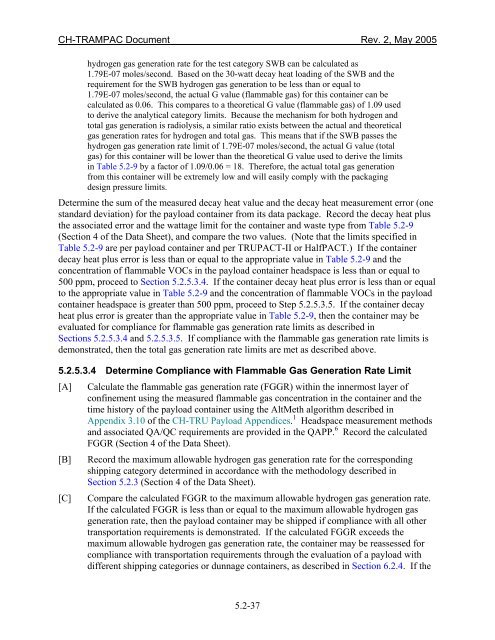CH-TRAMPAC - Waste Isolation Pilot Plant - U.S. Department of ...
CH-TRAMPAC - Waste Isolation Pilot Plant - U.S. Department of ...
CH-TRAMPAC - Waste Isolation Pilot Plant - U.S. Department of ...
- No tags were found...
Create successful ePaper yourself
Turn your PDF publications into a flip-book with our unique Google optimized e-Paper software.
<strong>CH</strong>-<strong>TRAMPAC</strong> Document Rev. 2, May 2005hydrogen gas generation rate for the test category SWB can be calculated as1.79E-07 moles/second. Based on the 30-watt decay heat loading <strong>of</strong> the SWB and therequirement for the SWB hydrogen gas generation to be less than or equal to1.79E-07 moles/second, the actual G value (flammable gas) for this container can becalculated as 0.06. This compares to a theoretical G value (flammable gas) <strong>of</strong> 1.09 usedto derive the analytical category limits. Because the mechanism for both hydrogen andtotal gas generation is radiolysis, a similar ratio exists between the actual and theoreticalgas generation rates for hydrogen and total gas. This means that if the SWB passes thehydrogen gas generation rate limit <strong>of</strong> 1.79E-07 moles/second, the actual G value (totalgas) for this container will be lower than the theoretical G value used to derive the limitsin Table 5.2-9 by a factor <strong>of</strong> 1.09/0.06 = 18. Therefore, the actual total gas generationfrom this container will be extremely low and will easily comply with the packagingdesign pressure limits.Determine the sum <strong>of</strong> the measured decay heat value and the decay heat measurement error (onestandard deviation) for the payload container from its data package. Record the decay heat plusthe associated error and the wattage limit for the container and waste type from Table 5.2-9(Section 4 <strong>of</strong> the Data Sheet), and compare the two values. (Note that the limits specified inTable 5.2-9 are per payload container and per TRUPACT-II or HalfPACT.) If the containerdecay heat plus error is less than or equal to the appropriate value in Table 5.2-9 and theconcentration <strong>of</strong> flammable VOCs in the payload container headspace is less than or equal to500 ppm, proceed to Section 5.2.5.3.4. If the container decay heat plus error is less than or equalto the appropriate value in Table 5.2-9 and the concentration <strong>of</strong> flammable VOCs in the payloadcontainer headspace is greater than 500 ppm, proceed to Step 5.2.5.3.5. If the container decayheat plus error is greater than the appropriate value in Table 5.2-9, then the container may beevaluated for compliance for flammable gas generation rate limits as described inSections 5.2.5.3.4 and 5.2.5.3.5. If compliance with the flammable gas generation rate limits isdemonstrated, then the total gas generation rate limits are met as described above.5.2.5.3.4 Determine Compliance with Flammable Gas Generation Rate Limit[A] Calculate the flammable gas generation rate (FGGR) within the innermost layer <strong>of</strong>confinement using the measured flammable gas concentration in the container and thetime history <strong>of</strong> the payload container using the AltMeth algorithm described inAppendix 3.10 <strong>of</strong> the <strong>CH</strong>-TRU Payload Appendices. 1 Headspace measurement methodsand associated QA/QC requirements are provided in the QAPP. 6 Record the calculatedFGGR (Section 4 <strong>of</strong> the Data Sheet).[B][C]Record the maximum allowable hydrogen gas generation rate for the correspondingshipping category determined in accordance with the methodology described inSection 5.2.3 (Section 4 <strong>of</strong> the Data Sheet).Compare the calculated FGGR to the maximum allowable hydrogen gas generation rate.If the calculated FGGR is less than or equal to the maximum allowable hydrogen gasgeneration rate, then the payload container may be shipped if compliance with all othertransportation requirements is demonstrated. If the calculated FGGR exceeds themaximum allowable hydrogen gas generation rate, the container may be reassessed forcompliance with transportation requirements through the evaluation <strong>of</strong> a payload withdifferent shipping categories or dunnage containers, as described in Section 6.2.4. If the5.2-37
















